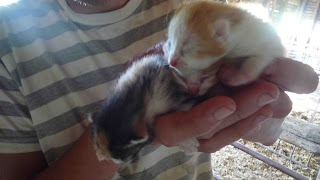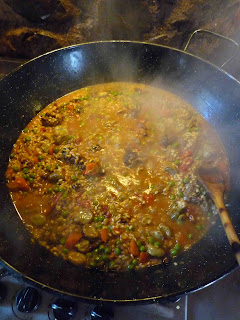Friday, 28 May 2010
Problema pequeña
Tuesday, 25 May 2010
Lunch over looking Africa

Tarifa... The Southern most point of mainland Europe, where two continents stretch out to one another, finger tips almost within touching distance. Arabic and Iberian culture fuse with one another after years of fruitful cross pollination.
Climbing through the winding streets through the old town, the languid, easy going nature of this city becomes apparent. For years it was a fiercely faught-over gateway to neighbouring civilisations, now it's one of the biggest attractions on the the Costa De Luz; A welcoming pit stop for travellers heading South into Africa, and a haven for the wind and kite surfers of the world, all searching for the perfect rip.
The most traditional of Andaluz cafes spill out into the streets and plazas, complete with all the Arabic hallmarks of palms, fountains, and blue and white mosaic tiles. Meanwhile 'alternative' culture nestles in comfortably besides, all ecotherapies, vegan pizzas, piercings, tattoos and dreadlocks.
At the highest point of the town stands the Mirador Del Estrecho. A single tower standing proudly to attention, presenting a Spanish flag across the water to Tangier, Morroco and the remainder of the world that lies beyond.
Sheltering to one side of the courtyard that surrounds the lookout, I lay my lunch out on the bench beside me. It's a modest assortment, but nonetheless, one I don't think I'll ever tire of: Fresh bread, ripe tomatoes bought from an old lady at a street stall, and a sweet, juicy orange bearing the paper wrapper branding of Naranjos Sastre de Sevilla. I stare out to sea for minutes on end between each mouthful, and the next time I look at my watch, almost an has passed before me. It's amazing how enthralling a dark band across the horizon can be...
Below lies the Playa de Los Lances where the the world's second largest ocean is funnelled into a bottle neck at the Straights of Gibraltar, there are five kilometres of windswept shore that is constantly pounded with the full force of nature's elements. After stashing my bag beneath an as yet unopened beach bar on the sand dunes, I head off to the water, spending the remainder of the afternoon body boarding in the frothy white waters of the Atlantic.

I finish my meal as the sun finishes it's long, slow kiss with the ocean, far away on the horizon. Leaning back on my chair, I look to the south, as the last of the highlights drop from from the cliffs of Africa's northern shores. The light dims over the Costa De Luz. A whole continent begins to fade into the dark, evening sky. And then, it is gone.
Friday, 21 May 2010
Little creatures, big in Andalusia

Thursday, 20 May 2010
Wednesday, 19 May 2010
Los Toros

Thirty one degrees in la calle,
Paseo de Cristobal Colón.
Heat fuels the sense of expectancy,
The afternoon has come.
The whole world is heading in one direction,
To see. To be. To be seen.
Today they stroll with a purpose,
Working man and bourgeoisie.
Sol o Sombre? Alto o abajo?
Keep the glare out of your eyes.
Here, the spectacular awaits us,
History in reprise.
Out of the tunnel and into the Plaza,
Tradition to cherish and hold.
A vision of this fair country,
In shades of claret and gold.

It's time: Horns blow, the show begins,
Every sight and every sound.
A microcosm of pain and pleasure,
Contained within the round.
Six bulls unleashed; noble beasts,
Beautiful. Powerful. Pure.
Six matadors and their muletas,
Red cloaks, daggers and swords.
Shadows stretch to touching distance.
Face to face and eye to eye.
Sequins and tassels will draw attention,
But fear they cannot hide.
Instinct guiding every act,
Predator, pray; Role reversal.
Events may twist and turn before us,
The results are always mortal.
The blade is drawn, fate is set,
The result given before it begins.
Noble beast versus the people's coward,
In a game it can never win.
Tuesday, 18 May 2010
Las Terrazas

Saturday, 8 May 2010
Fiestas... todos los dias
Un día typíco

Sunday, 2 May 2010
The horn of Salamanca

Picture the scene: It's late spring, sometime in the early eleventh century and the university city of Salamanca is burgeoning as one of the intellectual centres of the Iberian peninsula. In turn, this new found significance has led to increased wealth, and the men at the top with the heavy pockets and loose purse strings are in need of some frivolities to spend their pieces of silver on. Thankfully, help is at hand to ensure that some of it finds it's way back to the working classes, in the form of the world's oldest profession, prostitution.
Meanwhile, Christianity has taken hold big time of late, the hillock that overlooks the river now has a huge cathedral sat upon it, the bishop is pulling no punches on the town council, and all those rich, idol menfolk are being told that those whores to whom they are all so fond of are strictly off limits...
Fast forward a thousand years or so, and Salamanca's working women are still the people to see if you want to spend your disposable income, however, their profession is somewhat less sinful. Nowadays, they've swapped street corners for sweet counters, having taken up residence in the many pastelerias that are to be found across the city. Whilst the shelves are always well stocked with cakes, biscuits and pastries, in this town, centre stage is inevitably given over to Salamanca's trademark savoury treat, the hornazo.

Hornazos are undoubtedly Salamanca's leading contribution to Spanish gastronomy, they are part of the empenada family – essentially a stuffed savoury pie, similar to what we know as a pasty. Empanadas can be found in various guises the length and breadth of the country. In the Balearic Islands they're small and cute, with crimped edges and decorative egg wash. In Madrid, we ate them hot from the oven at El Mercado de San Miguel, filled pimenton and ground pork. In Galicia the pastry is made with grasa de cerdo, and they're filled with berberechos... A cockle pasty, made with pig fat - you wouldn't find that on the stall at Euston Station, would you?
Salamanca's version is, I think it's safe to say, a little more upmarket, and very carnivorous. This being prime pig country, the hornazo is gordy and fat, thick with layers lomo pork fillet, slices of cured salchichon sausage, huge discs of chorizo, generous rashers of jamon iberico, and just incase that wasn't enough protein, a few boiled eggs thrown in for good measure... Say, I don't know, a dozen.
I first encountered the hornazo in Galicia, when a Salamancan guest brought one to the farm I was staying on as a gift. I was so taken with it that I've come to their point of origin to find out more, and to sample the goods on their home turf. Salamanca is one of Spain's most architecturally significant cities, home to the second-oldest university in the country, and an important stop off for pilgrims who are hoping to walk their way to salvation. Meanwhile, I've come here solely on the strength of a meat pie.
So instead of spending my last day in Salamanca sight seeing, I went to an industrial estate on the south side of the city to meet with Raquel Soria of Hornazo de Salamanca. Hornazo de Salamanca are to hornazos what Heinz are to ketchup, and Raquel is la primera campañera, and therefore something of an authority in the world of luxury meat pies. She says that the secret to a good one is plump, juicy rounds of chorizo, placed on top of the slices of the pork fillet - taken from the finest iberian iberian black pigs - so all the meat stays moist during the cooking.
All well and good, but what does all this have to do with the rich folk yesteryear and their hookers? Well, the hornazo is a dish that marks the passing of Lent and they're traditionally eaten outside "in the field" on Easter Monday. You don't have to be a genius to work out that Christian calender was based around existing pagan festivals, and Lent – a period of austerity, is preceded by celebrations or carnival.
A little excursion into etymology: The word carnival, which is Latin in origin, unsurprisingly holds it's roots close to the word carne, and therefore implies not only meat, but also sex. It appears Salamanca's upper classes found it hard to give up either during Lent, and eventually the only way to put a stop to their loosed-loined behaviour was to banish all the prostitutes from the city, to the other side of the river Tormes. And to make times even tougher, meat was off the menu for forty days and nights as well.
Legend has it that by the time Lent was up, the men were all so gagging for it, they went down to the river to meet the returning hookers, planning to stay there so long, that they all packed a meaty lunch box. I realise that euphomisim was all too obvious, and I apologies, however they are Raquel's words, and not mine, so who am I to argue?





















